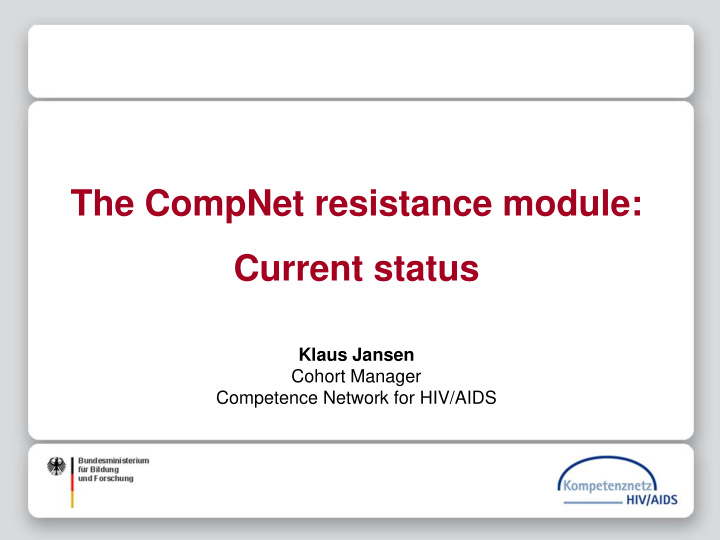



The CompNet resistance module: Current status Klaus Jansen Cohort Manager Competence Network for HIV/AIDS
Aims of the resistance database • Collection of data on resistance of patients of the CompNet HIV/AIDS cohort • Linkage of virologic data with clinical and sociodemographic data • Analyses of course of disease and specific resistance patterns etc. • Participation on national and international research projects
Topics of scientific interest Prevalence of resistant HIV in population of CompNet-cohort Differences in therapy outcomes in patients having resistant HIV or in patients having not Differences in therapy outcomes in patients having a previous resistance testing and harmonised therapy and in patients having no testing Analyses of impact of resistances on TCE Identification of new resistance patterns of new therapeutic regimens Impact of differing variants of HIV on clinical outcome of treated patients .....
CompNet-cohort Composition Basis-Module: 25 HIV-centres 10 clinics 15 special. private practitioners Resistence-Module: 9 Labs Children-Cohort: 8 centres Pregnancy-Cohort: 10 centres Neurology-Module: 1 centre Central Office CompNet CCT Cologne
Central cohort characteristics Prospective und retrospective documentation of 283 sociodemographic and clinical items Number of patients: - total: ~ 16.500 - currently under Follow-up: ~8.200 (1/4 of all treated patients in Germany) Person years - total: 62.900 person years - under treatment: 55.900 person years - prospective: 24.100 person years (since start in 2004) Sex: 85,4% men Main risk: 62.4% MSM main aspects representative for German epidemiological situation
ART-Status Mean duration since HIV-diagnosis: 10.3 years Mean duration between HIV-diagnosis and initial ART: - Men: 3.9 years - Women: 4.2 years Therapy status: - 12.6% ART-naive - 87,4% ART-experienced: 14.2% Initial Therapie 85.8% Follow-Up-Regimen - ~ 4,800 patients ART-naivity assured documented
Biomaterial-Banks Current number of samples Number of samples Storage Serum-bank 51.899 de-central DNA-bank 14.787 central CSF-bank 1.468 central Skin-bank 1.660 central Mucosa-bank 3.500 central Lymph node tissue-bank 120 central
Aspects as to data protection Data protection very important topic as to involving of patients Big fear of getting tracked as source of infection by restistance analyses, therefore: complex and secure data flow early involvement of patient representatives in setting up restistance-DB need of secure data handling in scope of all collaborations
Structure of Resistence-DB SmartGene Webserver Database Virologist Physician SmartGene SmartGene Gen sequences + Sample Sequence number Sequence number Resistance analyses Sequence number, PID + Analyses of mutations Sequence number ZKS -Köln Merged Data for MACRO Database external Webserver (clinical data and cooperation analyses of mutations)
Current status IT-tool for entry, storage and analyses: SmartGene-software Implemented targets: PR, RT, IN, gp41 Implementation of software and training in all labs Collection of retrospective data ongoing Partly, greater efforts while identifying retrospective sequences due to changes in lab-documentation systems etc. Collection of prospective data concurrently
Current status Only inclusion of data of patients having international IC Only existing sequences are recorded, no extra testing Coverage of CompNet-patients by 9 labs: ~ 76% Current # of eligible patients having int. IC: 5,175 Documentation: - Current # of tests in clinical database: ~2.000 - Current # of sequences in SmartGene: 948 ongoing documentation
Data and Networking Sharing of data set with researchers from inside and outside of CompNet appreciated Requests possible for virologic data as well as in combination with clinical and sociodemographic data Short proposal needed for conducting scientific projects Proposal evaluated by scientific boards and SC of CompNet After evaluation of proposal, data could be provided in different formats Important: analysing and avoiding overlaps with other German patient populations only slight overlaps expected
your attention! Thank you for
Recommend
More recommend